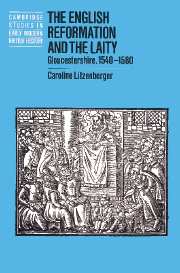Book contents
- Frontmatter
- Contents
- List of figures
- List of tables
- Acknowledgments
- Abbreviations and conventions
- Introduction
- 1 Setting the scene
- 2 Gloucestershire in the 1530s
- 3 The new diocese of Gloucester (1540–1546)
- 4 The advent of Edwardian Protestantism (1547–1553)
- 5 A return to the old religion (1553–1558)
- 6 The early years of Elizabeth's reign (1559–1569)
- 7 The clarification of the religious settlement (1570–1580)
- Conclusion
- Appendix A Sources and methodology
- Appendix B Results of wills analysis
- Appendix C Parish finances
- Bibliography
- Index
- Cambridge Studies in Early Modern British History
7 - The clarification of the religious settlement (1570–1580)
Published online by Cambridge University Press: 23 November 2009
- Frontmatter
- Contents
- List of figures
- List of tables
- Acknowledgments
- Abbreviations and conventions
- Introduction
- 1 Setting the scene
- 2 Gloucestershire in the 1530s
- 3 The new diocese of Gloucester (1540–1546)
- 4 The advent of Edwardian Protestantism (1547–1553)
- 5 A return to the old religion (1553–1558)
- 6 The early years of Elizabeth's reign (1559–1569)
- 7 The clarification of the religious settlement (1570–1580)
- Conclusion
- Appendix A Sources and methodology
- Appendix B Results of wills analysis
- Appendix C Parish finances
- Bibliography
- Index
- Cambridge Studies in Early Modern British History
Summary
After the ambiguity of the 1560s, official religion in the second decade of Elizabeth's reign was remarkably well focused and more energetically enforced that it had been previously. The emphasis would be on actions rather than thoughts, public worship rather than private prayer. Thus, attending church was more important to the Crown than taking communion, and priests' attire was more important than their knowledge (at least if one is to judge by the penalties for transgressing the rules). Not only did those in power have a relatively clear vision of acceptable Protestantism, but they also had the advantage over previous reigns of having a reasonably stable policy which had been in place for several years. They may have clarified and even narrowed the boundaries of acceptable religious expression, but at least the people had not been confronted by a swing of the religious pendulum in over ten years. In more and more parishes throughout the realm the externals of the new religion were becoming familiar. Elizabethan Protestantism was becoming a known quantity to increasing numbers of people; and yet, even in 1580, the movement toward full acceptance of the new religion would be just beginning.
In the 1570s, Elizabeth and her advisors were finding new means of enforcing conformity among the nobles and gentry. The saga of the Berkeley/Lisle land dispute and the related ‘poaching war’ provided such an opportunity. While ostensibly a dispute over land, it took on religious overtones during Elizabeth's reign, and seems to have involved a number of Gloucestershire gentry.
- Type
- Chapter
- Information
- The English Reformation and the LaityGloucestershire, 1540–1580, pp. 126 - 160Publisher: Cambridge University PressPrint publication year: 1997



